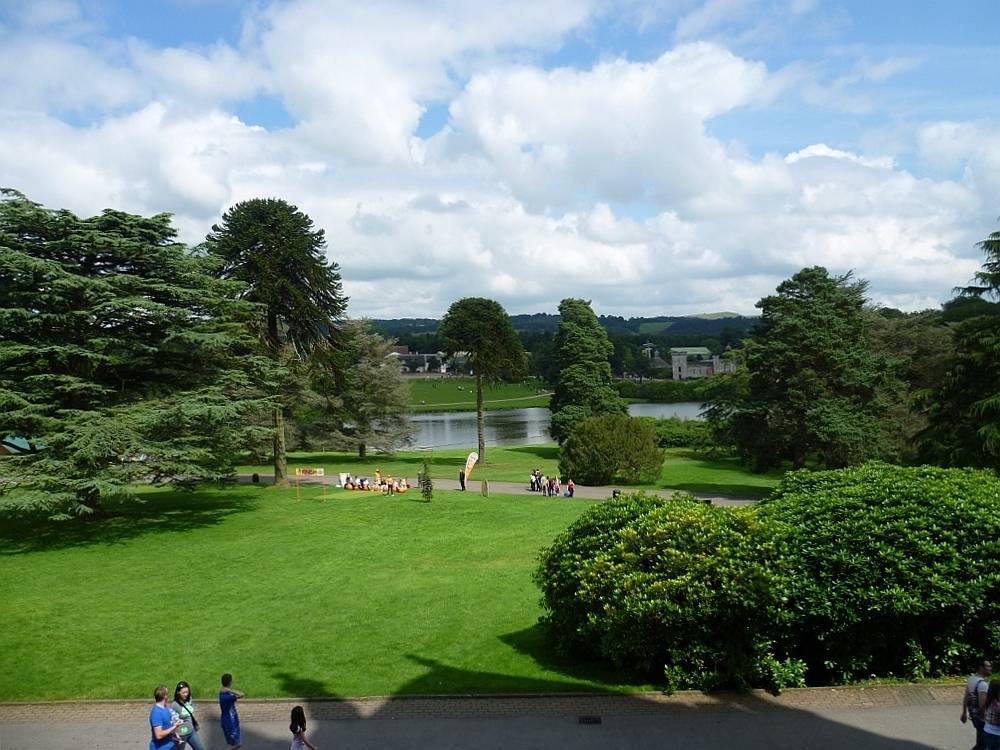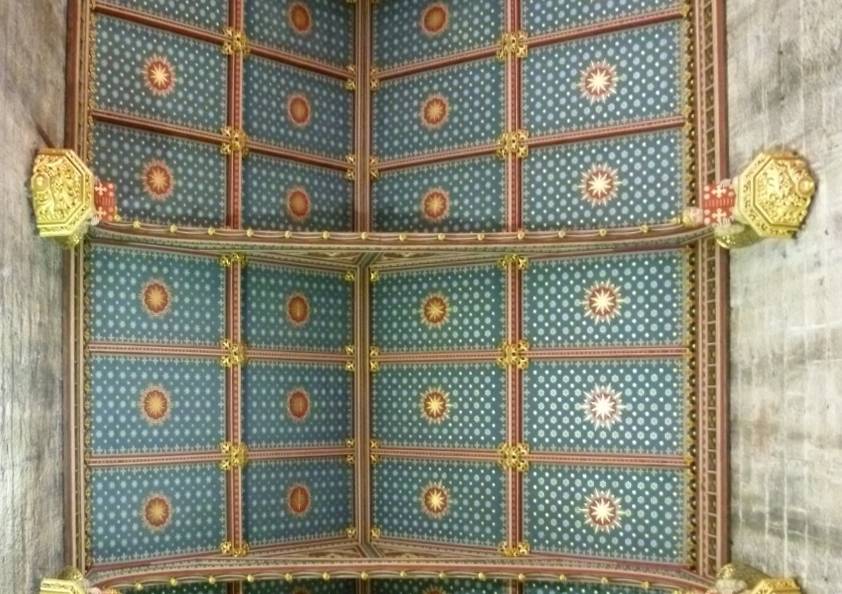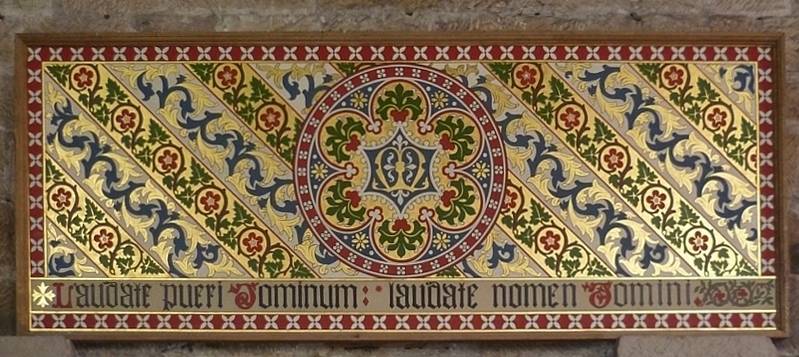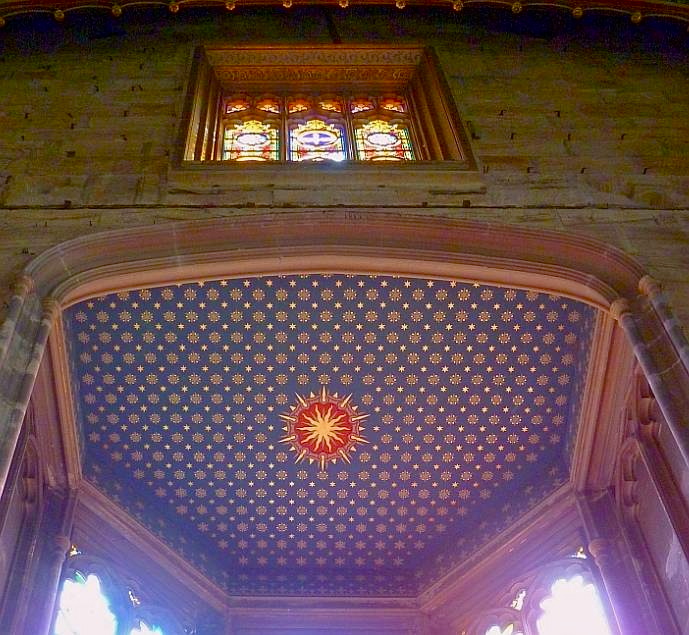Photographs by the author. [You may use the images without prior permission for any scholarly or educational purpose as long as you (1) credit the photographer and (2) link your document to this URL in a web document or cite it in a print one. Click on the thumbnails for larger pictures.]

The north front of Alton Towers as it is today, forming the romantic backdrop to a popular theme park. The Entrance Hall and Great Dining Room or Banqueting Room, rebuilt and greatly altered by Pugin, are in the tall gabled block currently (2012) with scaffolding. The tall tower just to its left is that of the Chapel, which Pugin redecorated and refitted.
Alton Towers, Farley, Staffordshire, with many alterations and additions by A. W. N. Pugin (1812-1852), carried out from 1837 until the time of his death. This is a Grade II* listed building. The work was commissioned for the wealthy Roman Catholic Earl of Shrewsbury, John Talbot, whose patronage was so valuable to Pugin. It seems to have begun after Pugin sent a copy of his book Contrasts to the Earl's chaplain, Dr Daniel Rock, in the autumn of 1836. The book struck a chord in Dr Rock, who shared his views on both Catholicism and architecture. He wrote appreciatively to the young author, sharing his enthusiasm for the work with the Earl — who in turn contacted Pugin himself. "So began the connection that was to be of central importance to both men for the rest of their lives" (Hill 168). Pugin's diary shows that he first set off for Alton at the very end of August 1837, and on October 23 that year a note in Alexandra Wedgwood's edition of the diary reads, "From this date Lord Shrewsbury's patronage of Pugin began" — though, as Stanley Shepherd points out, the initial project is not specified (see Shepherd 327). What is sure is that thereafter Pugin often visited Alton, writing to Earl on 4 July 1843, for example, "I Look forward with delight to get into such a haven" (Collected Letters 2: 88).
The Setting

View from the small dining room at Alton Towers.


Left to right: (a) Monument to Charles Talbot, the fifteenth Earl of Shrewbury, who first "made the desert smile," and spent much of his energy in doing so. (b) The end of the Grand (garden) Conservatory, by Robert Abraham (1774-1850).
Pugin visited Alton Towers not just as a guest but on a mission. The sixteenth Earl had inherited his title and the estate from his childless uncle in 1827. The house itself had once been a country lodge, and then a summer residence romantically dubbed "Alton Abbey." Now it was to be transformed into the ideal Catholic demesne. It was to express and celebrate a continuity of tradition from the medieval past, much as the Catholic Church of St Giles in Cheadle was to express and celebrate this tradition in ecclesiastical terms. In neither case was this merely a matter of outward appearance. The spirit of that tradition was to be clothed in, and shine through, the architecture. Just as his uncle had brought the arid valley to life, the Earl and Pugin, together with Pugin's team of craftsmen, would turn its centrepiece into a manifestation, proof and hub of the Catholic Revival.

Inside Alton Towers' immediate grounds are manicured gardens and views of towers and turrets. Pugin added to the Towers' defences not just for appearance, but because of the local unrest at this time — both in the Pottteries and in the mining community (see Fisher, "Gothic For Ever," 89).
There was scope in this vast residence for all Pugin's predilections: for his love of spectacle and his delight in fortifications, both already expressed in his first house, St Marie's Grange in Salisbury; for his aims as a church architect, since the Towers had its own chapel which he could remodel and refit; and for lavish, beautifully executed interior decoration. Between 1840 and 1847 he would (amongst other improvements and roughly in this order) refurbish the Chapel, rebuild the Octagon with its great central column, add on the elegant Talbot Gallery towards the west tower, build a wall with a Barbican gateway at the north east, and add new kitchens, a new grand Dining or Banqueting Hall, and a whole set of new rooms over the Drawing Room. He would even reroof and tile the House Conservatory, designed by Thomas Hopper (1776-1856), which led from the Drawing Room to the Octagon (see Fisher, "Gothic For Ever," 82, and Alton Towers, 18). It was a vast and time-consuming undertaking.
The Dining Hall



Left to right: (a) Closer view of the Entrance and Dining Hall block. (b) The roof of the Dining Hall. (c) One of the two Dining Hall fireplaces, showing the Shrewsbury arms, with two hounds either side of the lion.
The Dining Hall was to be like a medieval hall, hence the roof, described in the listing text as having "arch braced collars with king-posts over, openwork panels between collars and principals, curved wind-braces, one pair of purlins and ridge piece, central louvre, painted green and gold." Only the chain for the enormous 42-light brass and crystal chandelier, which Pugin proudly showed off in the Medieval Court at the Great Exhibition, still hangs from it (see Fisher, "Gothic For Ever," 104). Indeed, only fragments of the whole great enterprise remain now, at least until further restoration is possible. The deaths of Pugin and his patron in late 1852 were followed, after a few years' interval, by an expensive legal battle over the inheritance, necessitating the auction of all the estate's precious contents. During the first six of the thirty days of sale, over 700 pictures were offered, including works by Caravaggio, Rubens, Titian, Velasquez and Durer. Everything went, including the kitchen copper, deal tables, carriages, horses and harnesses, and curiosities like a "bit of Mary Stuart's bed curtain" and some slippers from the Bishop of Cincinnati (Catalogue, items and 1430 and 1431, p. 89). The very fabric of the building was eventually stripped and left to rot, so that Nikolaus Pevsner found it, in the early 1970s, "in large parts in ruin" (56).
The Chapel



Chapel, left to right: (a) Chapel exterior, from the south-east end. (b) Chapel roof. (c) Chapel gallery.

The one surviving panel of the Chapel's original frieze.


Left: Looking up past the interior of the oriel. Note the Willement window above. Right: Stained glass in one of the chapel's side windows, showing some damage.
The Chapel at Alton Towers had only just been completed when Pugin arrived on the scene, and already had its gallery, the large corbel angel with their open books, and stained glass windows in the apse by William Willement. Dr Rock had had a say in its design. But Pugin soon set to work on it, designing a reredos and a splendid carved screen of gilded wood — the latter with angels and saints represented in it. The ceiling was brilliantly painted as the stylised heavens, the corbel angels picked out in colour and partially gilded, and an intricate gilded frieze added, made up of twelve panels each carrying a central "M" for the Virgin Mary, and with the Latin text of Psalm 113 along the lower edge (in the King James version, it begins, "Praise ye the Lord. Praise, O ye servants of the Lord, praise the name of the Lord"). Although the listing text simply has "stained glass by Willement," another stained-glass maker, William Warrington, who was executing Pugin's designs during the earlier part of the period, also recorded an order for: "Chapel 2 Quatrefoils" (see Shepherd 327), so it seems that more was added. In this brilliantly redecorated Chapel, Pugin's second wife Louisa was received into the Catholic Church in a "spectacularly staged ceremony" in May 1839 (Hill 210; see also Fisher, "Gothic For Ever," 96-97).
The House Conservatory



Hopper's Conservatory, its roof restored by Pugin and restored again in 2011, and with part of Pugin's Minton tile paving still in place.
Allowing Alton Towers, a key document in the history of the Gothic Revival, to go to ruin must count as one of the twentieth century's worst sins against its — and our — Victorian heritage, and it will probably never be possible to recreate Pugin's work on it. But the Towers' English Heritage listing in 1951, and the Historic Buildings and Ancient Monument Act of 1953, helped prevent an even worse fate (i.e., demolition), and the costly effort to make the various structures safe, and to restore at least some of them, is now beginning to show results (see Fisher, Alton Towers 28, and "Gothic For Ever," 310-12).
Sources
"Alton Towers and Attached Garden Walls and Gatehouse, Farley." British Listed Buildings. Web. 30 November 2012.
Catalogue of the Magnificent Contents of Alton Towers, the Princely Seat of the Earls of Shrewsbury. London: Messrs. Christie & Manson, 1857. Internet Archive. Web. 30 November 2012.
Fisher, Michael. Alton Towers. Stoke on Trent: Urban Vision North Staffordshire., 2012 (one of a set of four guidebooks to Pugin's North Staffordshire buildings). Print.
_____. "Gothic For Ever": A. W. N. Pugin, Lord Shrewsbury, and the Rebuilding of Catholic England. Reading: Spire, 2012. Print.
Hill, Rosemary. God's Architect: Pugin and the Building of Romantic Britain. London: Penguin, 2007. Print.
Pevsner, Nikolaus. Staffordshire. Buildings of England series. London: Penguin, 1974. Print.
____. The Collected Letters of A. W. N. Pugin, Vol. 2. 1843-45. Ed. Margaret Belcher. Oxford: Oxford University Press, 2003. Print.
"Roman Catholic Church of St GIles." British Listed Buildings. Web. 30 November 2012.
Last modified 4 December 2012